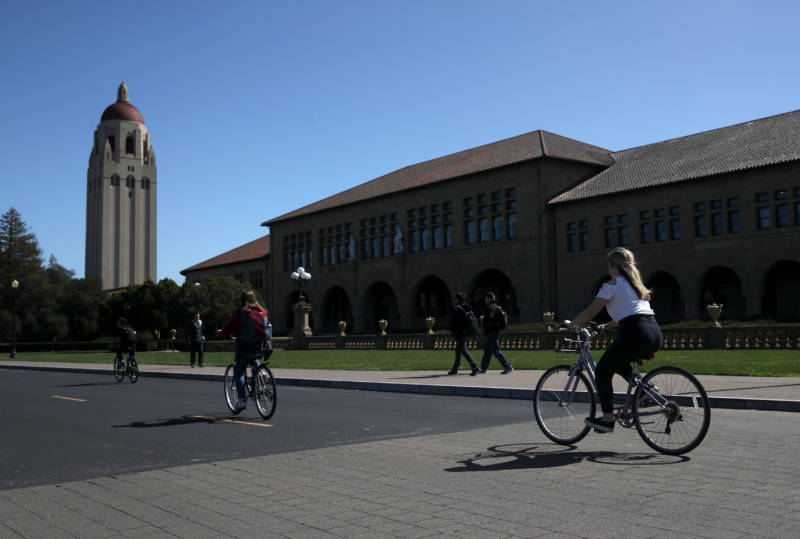Yet, according to a recent analysis by the Bay Area News Group of federal loan data from the 2016-17 academic year, students who graduated from Stanford with a bachelor’s degree had the lowest average debt, compared to graduates at any other four-year college or university in the Bay Area. The average federal loan debt among graduates there came to roughly $13,800, thousands of dollars less than several nearby public universities with significantly lower tuition rates.
Graduates of nearby San Jose State University, for example, had an average debt burden of about $17,700.
What’s more, fewer than 20% of Stanford graduates enter the real world with any loan burden whatsoever.
And that’s where Stanford’s $26.5 billion endowment comes into play.
“Ten years ago, we stopped expecting students to borrow as part of their financial aid package,” explained Karen Cooper, Stanford’s financial aid director. “We realized that lo and behold, people from low-income backgrounds weren’t applying because the sticker price was so scary.”
Today, Stanford covers full tuition for any students whose parents make less than $125,000. And students whose families make less than $65,000 get a free ride and also have their room and board covered, Cooper said. In both cases, she added, those students have to work during the academic year and contribute $5,000.
Only a minuscule percentage of applicants to Stanford are actually admitted, Cooper noted. And among the select few that are, most don’t have to worry about how they’ll pay for it.
“No students, regardless of income, are expected to borrow,” she said. But for those who do, she added, “we took loans out of the equation.”
And therein lies the obvious irony: The average debt burden at Stanford and other highly selective, well-endowed private elite universities is substantially lower than it is at schools that typically serve much larger populations of lower-income students. In other words, debt is often higher at universities that on the face of it seem more affordable.
Today, total U.S. student loan debt is nearly $1.6 trillion, more than four times what it was a decade ago, far outpacing total U.S. credit card debt. Nationally, about 65% of college seniors who graduated from public and private nonprofit colleges in 2017 had some student loan debt, owing an average of about $28,650, according to The Institute for College Access and Success.
KQED’s Ryan Levi spoke last month to Leonardo Castañeda, who covers demographics and income inequality for the Bay Area News Group, and first reported the Stanford story.
The interview below has been lightly edited for length and clarity.
Ryan Levi: Can you start by telling me how you reached what, on its face, might seem like a pretty surprising conclusion?
Leonardo Castañeda: Yeah, it is surprising. One of the requirements that the Department of Education has is, they want to know for each major and each university, how many students graduated with loans and how much the average loan was for those students. When you can bring all of that together and look at the Bay Area, Stanford actually has the lowest average for their students. They also have very few students who take out loans, which is kind of part of this process.
RL: And how much are we talking about? What kind of loan debt are these students leaving with on average?
LC: On average they’re leaving with about $14,000. UC Berkeley is the next closest one. The CSUs, San Francisco State, San Jose State, CSU East Bay, are pretty close — they range from about $15,000 to about $17,000 on average. So not a massive difference, but $3,000 can go a long way before or after college, and that’s [just] the average.
RL: And so, is this simply a case of private schools being able to give out more financial aid, outweighing their often higher attendance costs?
LC: Absolutely. That’s a huge part of it. Stanford has a $26.5 billion endowment. So that gives them a lot of latitude to subsidize a lot of their students. They also have a lot of students who don’t need any financial aid, who are able to pay out of pocket. A CSU might serve a more lower-income, broader base of students. So [Stanford] has the resources, they have the donors, they have that infrastructure to give it a lot more money than a state school does.
RL: Now, you look specifically at federal student loan debt. Is there any way to know if this conclusion holds true when you factor in private loans?
LC: What we found is that it is pretty close. About $20,000 is the average for the most recent graduating class [at Stanford], and that’s about the same as the CSUs. It is much lower than most other private schools where the average, including non-federally subsidized private loans, is about $25,000 to $27,000. So even if you take into account those non-federal loans, it is still very, very low.
RL: And has this always been the case at Stanford?
LC: This is actually a conscious decision that Stanford made for the 2008-09 school year, where they said, “OK, let’s reimagine how we present this package. Let’s take loans out of the equation. How much can parents pay? We’ll cover the rest.” So since then, they’ve seen about two-thirds of their students graduate without any loans at all. That number is down to about 19 percent. And the average has stayed about flat.

